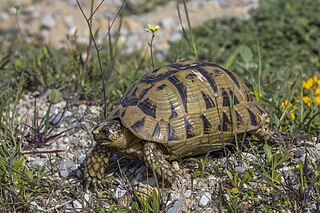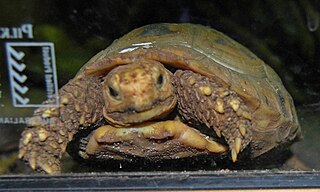
Tortoises are reptiles of the family Testudinidae of the order Testudines. Like other turtles, tortoises have a shell to protect from predation and other threats. The shell in tortoises is generally hard, and like other members of the suborder Cryptodira, they retract their necks and heads directly backward into the shell to protect them.

The Greek tortoise, also known commonly as the spur-thighed tortoise or Moorish tortoise, is a species of tortoise in the family Testudinidae. Testudo graeca is one of five species of Mediterranean tortoises. The other four species are Hermann's tortoise, the Egyptian tortoise, the marginated tortoise, and the Russian tortoise. The Greek tortoise is a very long-lived animal, achieving a lifespan upwards of 125 years, with some unverified reports up to 200 years. It has the largest known genome of all reptiles.

The Russian tortoise, also commonly known as the Afghan tortoise, the Central Asian tortoise, the four-clawed tortoise, the four-toed tortoise, Horsfield's tortoise, the Russian steppe tortoise, the Soviet Tortoise, and the steppe tortoise, is a threatened species of tortoise in the family Testudinidae. The species is endemic to Central Asia from the Caspian Sea south through Iran, Pakistan and Afghanistan, and east across Kazakhstan to Xinjiang, China. Human activities in its native habitat contribute to its threatened status.

The African helmeted turtle, also known commonly as the marsh terrapin, the crocodile turtle, or in the pet trade as the African side-necked turtle, is a species of omnivorous side-necked terrapin in the family Pelomedusidae. The species naturally occurs in fresh and stagnant water bodies throughout much of Sub-Saharan Africa, and in southern Yemen.

Chersobius signatus is the world's smallest species of tortoise. The species is commonly known as the speckled tortoise and also known locally as the speckled padloper and internationally as the speckled Cape tortoise. A member of the genus Chersobius, it is endemic to South Africa.

Forsten's tortoise, also known commonly as the Sulawesi tortoise, is a species of tortoise in the family Testudinidae. The species is native to Sulawesi Island, Indonesia.

The pancake tortoise is a species of flat-shelled tortoise in the family Testudinidae. The species is native to Tanzania and Kenya. There are also small populations in northern Zambia. Its common name refers to the flat shape of its shell.

Indotestudo is a genus of tortoises in the family Testudinidae. The genus is native to South and Southeast Asia. The three species in the genus are all threatened.

Chersobius solus, commonly known as the Nama dwarf tortoise, the Nama padloper, and Berger's cape tortoise, is a species of tortoise in the family Testudinidae. The species is endemic to Namibia.

Homopus is a genus of tiny tortoises in the family Testudinidae, endemic to southern Africa. Three species formerly included in Homopus were reclassified into the genus Chersobius, leaving two remaining as Homopus: the common padloper (H. areolatus) and the greater padloper (H. femoralis).

The angulate tortoise is a species of tortoise found in dry areas and coastal scrub vegetation in South Africa. This tortoise is the only known member of the genus Chersina.

The serrated tortoise German: Kalahari-Strahlenschildkröte is a species of tortoise that occurs in the Kalahari desert regions of southern Africa. Also known as the Kalahari tent tortoise, it is one of three members of the genus, Psammobates.

The tent tortoise is a species of tortoise and one of three members of the genus, Psammobates. Known locally as the Karoo tent tortoise, this highly variable species is found in South Africa and Namibia.

Speke's hinge-back tortoise, also known commonly as Speke's hingeback tortoise, is a species of turtle in the family Testudinidae. The species is endemic to Africa.
The Lobatse hinge-back tortoise or Lobatse hinged tortoise is a species of turtle in the family Testudinidae. It is found in Southern Africa.

Homopus femoralis, commonly known as the greater padloper, is a small tortoise of the genus Homopus, indigenous to the highveld grasslands of South Africa.

Chersobius boulengeri, commonly known as the Karoo padloper or Boulenger's cape tortoise, is a species of tortoise in the family Testudinidae. The species is endemic to the Nama Karoo Region of South Africa.

Harmony Flats Nature Reserve is a 9-hectare (22-acre) piece of protected land, located between Strand and Gordon's Bay, South Africa. It protects a surviving fragment of critically endangered Lourensford Alluvium Fynbos vegetation.

The Karoo Desert National Botanical Garden is a botanical garden focused on succulents and other plants of arid regions, that lies at the foot of the Hex River Mountains range, in the town of Worcester, South Africa.

Chersobius is a genus of tiny tortoises in the family Testudinidae, endemic to southern Africa. The genus includes the smallest tortoises in the world. All three species were previously assigned to the genus Homopus.
























